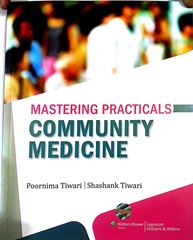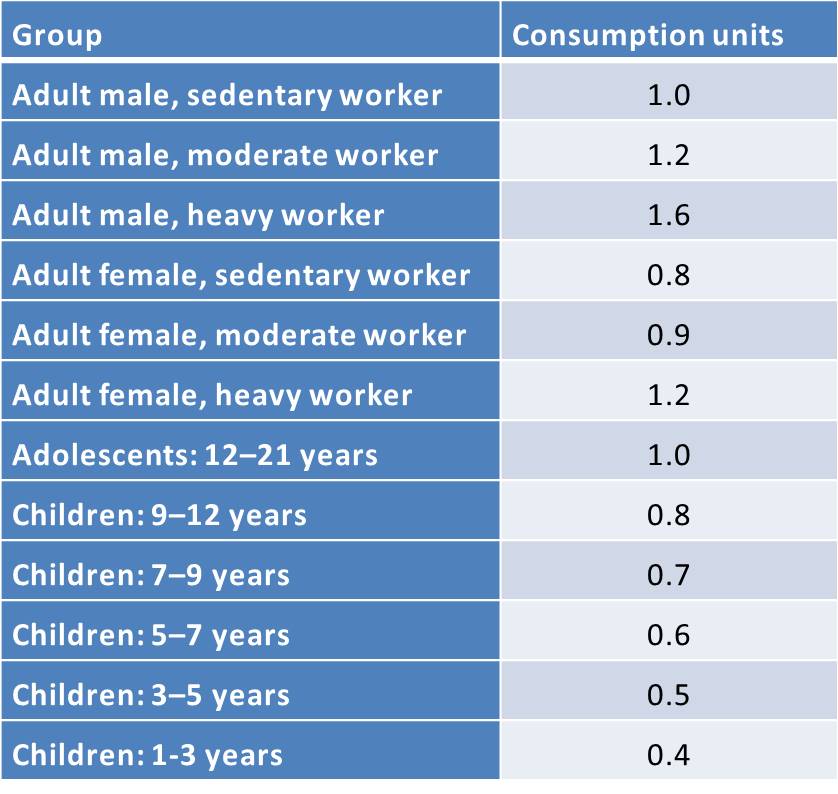
When the food intake of a community or a group of people is to be measured, the practical problem that arises is that the group is constituted by individuals of various ages and sex groups. Each group has a different set of such groups.
To resolve this issue, it is usual to assess the needs of women and children in terms of those of the average man by applying appropriate coefficients of calorie consumption suggested for practical nutrition work in India.
The energy consumption of an average male doing sedentary work is taken as one unit. The calorie requirement of women, children and males doing moderate and heavy work is expressed as relative to that of a sedentary man. One unit of coefficient corresponds to energy requirements relative to that of a sedentary man and one unit of coefficient corresponds to an energy requirement of 2400 kcal/day. This unit is the “Consumption Unit” (CU).
The concept of Consumption Unit (CU) has been developed by ICMR for assessing the need of energy only. However, National Nutrition Monitoring Bureau (NNMB) has been using the CU for other nutrients and food items intake also (as intake per CU) for nutritional surveys in India.
Table: Coefficient for Computing Calorie Requirement of Different Groups
Calculation of the Total Consumption Units of the Family
Allot the appropriate CU (as per the above table) to each family member. Add up the CUs and the total will be the number of CUs in the family.
An example is given here for the calculation of the number of CUs in the family.
• HOF—Male, 31 years old, clerk (sedentary worker): CU = 1
• Wife of the HOF—28 years old, housewife (moderate worker): CU = 0.9
• Elder child—12 year old, male: CU = 1
• Younger child—8 year old, male: CU = 0.7
Total CUs in the family 1 + 0.9 + 1 + 0.7 = 3.6
References:
1. ICMR. Nutrient Requirements and Recommended Dietary Allowances for Indians. Hyderabad: National Institute of Nutrition; 2009.
2. ICMR. Nutritive Value of Indian Foods. Hyderabad: National Institute of Nutrition; 1996.
3. Nutrition in India. UN ACC/SCN Country case study supported by UNICEF Annex I: food consumption data: the national nutrition monitoring bureau and national sample survey organization. Available at: http://www.unsystem.org/scn/archives/india/ch13.htm. Accessed January 13, 2012.
4. Gupta RK. Nutritional assessment and surveillance of a community. In: Vaidya R, Tilak R, Gupta R, Kunte R, editors. Text Book of Public Health and Community Medicine, 1st ed. Pune: Dept. Community Medicine, AFMC, in collaboration with WHO, India office, Delhi; 2009.
5. Park K. Nutrition and health. In: Park’s Textbook of Preventive and Social Medicine, 20th ed. Jabalpur, India: M/S Banarasidas Bhanot Publishers; 2009.
6. Poornima Tiwari, Shashank Tiwari. Chapter 13, In: Mastering Practicals in Community Medicine. 2nd ed. Lippincott Williams & Wilkins, New Delhi
(adsbygoogle = window.adsbygoogle || []).push({
google_ad_client: "ca-pub-2296304216845141",
enable_page_level_ads: true
});
Modified Kuppuswamy Classification of Socio - Economic Class: http://www.ihatepsm.com/blog/modified-kuppuswamy-scale
Prasad's Scale: http://www.ihatepsm.com/blog/prasad%E2%80%99s-scale
Dependency Ratio: http://www.ihatepsm.com/blog/dependency-ratio
Assessment of Overcrowding in a Household: http://www.ihatepsm.com/blog/assessment-overcrowding-household
Checking Adequacy of Lighting in a Room: http://www.ihatepsm.com/blog/checking-adequacy-lighting-room
Assessment of Adequacy of Ventilation: http://www.ihatepsm.com/blog/assessment-adequacy-ventilation
Family and the Types of Family: http://www.ihatepsm.com/blog/family-and-types-family
Checking for Mosquito Breeding Areas in a Household: http://www.ihatepsm.com/blog/checking-mosquito-breeding-areas-household
Life Cycle of Housefly: http://www.ihatepsm.com/blog/life-cycle-housefly
Types of Piped Water supply: http://www.ihatepsm.com/blog/types-piped-water-supply
Reference Indian Adult Man and Woman: http://www.ihatepsm.com/blog/reference-indian-adult-man-and-woman
Concept of the “Consumption Unit”: http://www.ihatepsm.com/blog/concept-%E2%80%9Cconsumption-unit%E2%80%9D
Methods of Dietary Survey: http://www.ihatepsm.com/blog/methods-dietary-survey
24-Hour Recall (Questionnaire) Method: http://www.ihatepsm.com/blog/24-hour-recall-questionnaire-method
Determination of Socio-economic Status of a Family in a Rural Area (the Uday Pareekh Scale): http://www.ihatepsm.com/blog/determination-ses-family-rural-area-uday-pa...
7 Terms used in Maternal and Child Health: Definition and Explanation: http://www.ihatepsm.com/blog/7-terms-used-maternal-and-child-health-defi...
Terms used in Family Health Study: Definitions and Explanations: http://www.ihatepsm.com/blog/terms-used-family-health-study-definitions-...
Lecture on the definitions and explanations of terms used in Family Health Study: http://www.ihatepsm.com/resource/terms-used-family-health-study-definiti...
Hindi lecture on the definitions and explanations of terms used in Family Health Study: http://www.ihatepsm.com/resource/terms-used-family-health-study-definiti...
Hindi lecture on CSC taking: https://www.youtube.com/watch?v=9gvuXrIJ_gY&t=10s
English lecture on CSC taking: https://www.youtube.com/watch?v=rKxXIyJuBz8&t=24s
Format for CSC taking: http://www.ihatepsm.com/blog/format-clinico-social-case-taking-community...
Geriatric CSC taking: http://www.ihatepsm.com/blog/geriatric-clinico-social-case-community-med...
